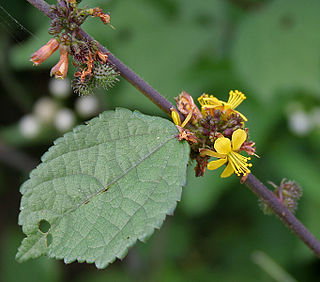
Ceiba is a genus of trees in the family Malvaceae, native to tropical and subtropical areas of the Americas and tropical West Africa. Some species can grow to 70 m (230 ft) tall or more, with a straight, largely branchless trunk that culminates in a huge, spreading canopy, and buttress roots that can be taller than a grown person. The best-known, and most widely cultivated, species is Kapok, Ceiba pentandra, one of several trees known as kapok.

Abutilon is a large genus of flowering plants in the mallow family, Malvaceae. It is distributed throughout the tropics and subtropics of the Americas, Africa, Asia, and Australia. General common names include Indian mallow and velvetleaf; ornamental varieties may be known as room maple, parlor maple, or flowering maple. The genus name is an 18th-century Neo-Latin word that came from the Arabic ’abū-ṭīlūn, the name given by Avicenna to this or a similar genus.
Bastardia is a genus of flowering plants in the mallow family, Malvaceae.

Melhania is a genus of small shrubs or herbaceous plants. Traditionally included in the family Sterculiaceae, it is included in the expanded Malvaceae in the APG and most subsequent systematics. The genus is named for Mount Melhan in Yemen.

Helicteres is a genus of flowering plants in the family Malvaceae. Its range is from tropical and sub-tropical Asia through to northern Australia, and also Mexico through to the northern half of South America.

Hibisceae is a tribe of flowering plants in the mallow family Malvaceae, subfamily Malvoideae.

Triumfetta is a genus of plants in the family Malvaceae. Burbark is a common name for plants in this genus.

Hermannia is a genus of flowering plants in the mallow family, Malvaceae. It comprises at least 65 species with many more species as yet unresolved.

Cienfuegosia is a genus of plants, in the family Malvaceae and placed in the tribe Gossypieae. Species can be found in central and south America, Africa including the Arabian peninsula.

Fuertesimalva is a genus of flowering plants in the mallow family Malvaceae, native to Mexico, Venezuela, Colombia, Ecuador, Bolivia, Peru and Argentina. Most species in this genus were originally placed in Urocarpidium.
Tarasa is a genus of flowering plants belonging to the family Malvaceae.

Malvastrum is a genus of flowering plants belonging to the family Malvaceae.
Modiolastrum is a genus of flowering plants belonging to the family Malvaceae.
Monteiroa is a genus of flowering plants belonging to the family Malvaceae.
Neobaclea is a monotypic genus of flowering plants belonging to the family Malvaceae. It only contains one known species, Neobaclea crispifolia(Cav.) Krapov.
Neobrittonia is a monotypic genus of flowering plants belonging to the family Malvaceae. It only contains one known species, Neobrittonia acerifolia
Peltaea is a genus of flowering plants belonging to the family Malvaceae.











